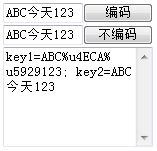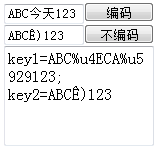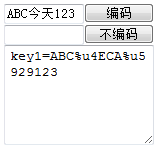CP9001: Firefox Safari 中对 cookie 中未经编码的中文汉字处理有问题
标准参考
根据 RFC 2965 规范说明了 cookie 的语法格式:
The two state management headers, Set-Cookie2 and Cookie, have common syntactic properties involving attribute-value pairs. The following grammar uses the notation, and tokens DIGIT (decimal digits), token (informally, a sequence of non-special, non-white space characters), and http_URL from the HTTP/1.1 specification [RFC2616] to describe their syntax.
规范中并没有指明 "非特殊、非空白字符" 是否包含中文汉字这类字符。
关于 cookie 的详细信息,请参考 IETF 组织制定的 "RFC 2965" 规范(HTTP State Management Mechanism)中第 3.1 节的内容。
问题描述
IE Chrome Opera 中,cookie 中可以保存 Unicode 字符;Firefox 则会将中文字符内码将被转换为 Unicode 编码;Safari 会忽略包含中文字符的键值对。
造成的影响
由于 Firefox 及 Safari 对设置 cookie 中包含中文汉字字符时的处理异常,将导致这两个浏览器在取回 cookie 的内容时,得到的字符串异常。
受影响的浏览器
| Firefox | |
|---|---|
| Safari |
问题分析
在本地创建一个 Apache 服务器,创建一个静态页面 cookie.html 放在 Web 服务器上。
代码如下:
<html> <head> <meta http-equiv="Content-Type" content="text/html; charset=gb2312" />
<style> input { width:80px; height:20px; } button { width:70px; height:20px; } textarea { width:
150px; height:100px; } </style> </head> <body> <input type="text" id="text1"
/><button id="button1">编码</button><br /> <input type="text" id="text2"
/><button id="button2">不编码</button><br /> <textarea id="ta"></textarea>
<script> function $ ( id ) { return document.getElementById(id); } function getCookie ( c_name,
dec ) { if ( document.cookie.length > 0 ) { c_start = document.cookie.indexOf(c_name + "="); if (
c_start != -1 ) { c_start = c_start + c_name.length + 1; c_end = document.cookie.indexOf(";", c_start);
if ( c_end == -1 ) { c_end = document.cookie.length; } var ret = document.cookie.substring(c_start,
c_end); return ( dec ) ? unescape(ret) : ret; } } return ""; } function setCookie ( c_name, value,
expiredays, enc ) { var exdate = new Date(); exdate.setDate(exdate.getDate() + expiredays); var val = (
enc ) ? escape(value) : value; document.cookie = c_name + "=" + val + ((expiredays==null) ? "" :
";expires=" + exdate.toGMTString()); } $("button1").onclick = function () { setCookie("key1",
$("text1").value, 365, true); } window.onload = function () { $("text1").value = getCookie("key1",
true); $("text2").value = getCookie("key2", false); $("ta").value = document.cookie; }
$("button2").onclick = function () { setCookie("key2", $("text2").value, 365, false); } </script>
</body> </html>
上面代码中,页面加载后会读取浏览器 cookie 中的内容,将 "key1" 的值先使用 "unescape" 进行解码,之后设置到文本框【text1】中,将 "key2" 的值直接设置到文本框【text2】中。
点击按钮【button1】则先将文本框【text1】中的内容通过"escape"编码,然后保存至 cookie 的 "key1" 下;点击按钮【button2】则直接将文本框【text2】中的内容保存至 cookie 的 "key2" 下。
在各浏览器中打开服务器中测试代码的地址,如:http://localhost/cookie.htm。页面第一次载入后,两个文本框均为空,此时在两个文本框中均输入一段文字,如 "今天ABC123" 。分别点击两个按钮,再刷新页面。
这段代码在不同浏览器中运行结果如下:
| IE Chrome Opera | Firefox | Safari |
|---|---|---|
 |
 |
 |
可见:
- 在 IE Chrome Opera 中,cookie 中可以保存 Unicode 字符,所以无论保存至 cookie 的字符是否编码,浏览器均能很好的读取出来;
- 在 Firefox 中,未编码的包含有中文汉字字符的 cookie 保存时,中文字符内码将被转换为 Unicode 编码(如“今天”的内码为“4ECA 5929”),英文字符则不受影响,在浏览器读取 cookie 时只识别 ASCII 码,导致 Unicode 编码内的高位丢失,造成取出的内容异常(如“今天”高位字符丢失成为“CA 29”编码,对应 ASCII 字符表显示为“Ê)”);
- 在 Safari 中,未编码的包含有中文汉字字符的 cookie 保存时,由于 cookie 仅可以保存 ASCII 字符,所以浏览器忽略了包含中文字符的键值对,其未被存入 cookie,导致读取时内容丢失。
解决方案
在设置和读取 cookie 时,始终为字符进行编解码操作,推荐使用 "encodeURIComponent" 和 "decodeURIComponent" 方法做相应编解码工作。
参见
知识库
相关问题
测试环境
| 操作系统版本: | Windows 7 Ultimate build 7600 |
|---|---|
| 浏览器版本: |
IE6
IE7 IE8 Firefox 3.6.3 Chrome 5.0.375.29 dev Safari 4.0.5 Opera 10.52 |
| 测试页面: | cookie.html |
| 本文更新时间: | 2010-06-23 |
关键字
cookie character chinese code escape unescape 乱码 中文 汉字





